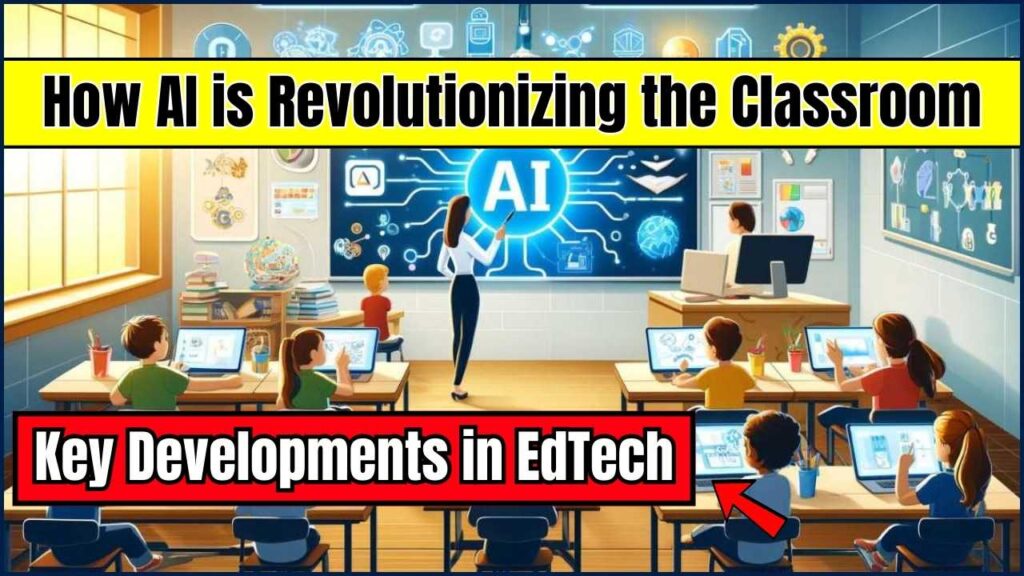AI is Revolutionizing the Classroom: Artificial Intelligence (AI) is no longer just a buzzword in the tech world—it’s changing how our kids learn, how teachers teach, and how schools operate behind the scenes. From personalized learning tools to tireless smart tutors, AI is straight-up rewriting the classroom playbook and shifting the entire education experience for students, teachers, and administrators alike.

Back in the day, we had chalkboards and textbooks. Fast-forward to 2025, and we’ve got AI-powered dashboards tracking student performance in real-time, bots grading essays in minutes, and virtual tutors helping kids 24/7. This isn’t a sci-fi dream—it’s today’s reality in a growing number of American classrooms. And if that doesn’t scream revolution, we don’t know what does.
AI is Revolutionizing the Classroom
| Feature | Description |
|---|---|
| Topic | How AI is Revolutionizing the Classroom |
| Key Developments | Personalized learning, AI tutors, automated grading, content creation, accessibility tools |
| Global Examples | UAE’s AI curriculum, UK EdTech funding, India’s Symbiosis AI Institute |
| Challenges | Data privacy, digital divide, teacher training, AI over-dependence |
| Source | U.S. Department of Education AI Report |
AI is revolutionizing classrooms by making learning more personalized, efficient, and inclusive. But it’s not a magic wand. To truly unlock its potential, we must train teachers, protect student privacy, and close the tech gap. With thoughtful implementation and constant evaluation, AI could help us build an education system where every student thrives—regardless of where they come from or how they learn.
Personalized Learning Is No Longer a Luxury—It’s the New Norm
AI in EdTech is mostly about making learning personal. Think of apps like DreamBox, Smart Sparrow, or Knewton. These tools don’t just spit out generic lessons—they analyze a student’s pace, performance, and even emotional reactions to tailor content. Like how Netflix figures out what you wanna binge next, these platforms figure out what lesson a student should tackle based on their individual learning curve.
This means a kid struggling in fractions can spend more time mastering it, while another zooms ahead to geometry. No one gets left behind or bored to death. Over time, the software adjusts itself, creating a dynamic and evolving curriculum that adapts to student needs. This tech is already helping kids with ADHD stay engaged longer and assisting advanced learners to reach their potential without waiting for the rest of the class.
Meet the AI Tutors — Your 24/7 Homework Buddies
Gone are the days when tutoring was only for those who could afford it. Thanks to AI tutoring systems, any student can get help at any hour. These bots aren’t perfect, but they’re getting scarily close to being virtual instructors.
Take Khan Academy’s Khanmigo, for example. This virtual assistant helps with math, science, writing—you name it. It provides instant, step-by-step explanations, encourages students through tricky problems, and even tells a joke or two to lighten the mood. Teachers are using it to plan lessons, identify struggling students, and reinforce class topics. Kids? They’re using it like a personalized coach who’s always available—even during snow days.
Some districts are testing AI platforms like Socratic by Google and Squirrel AI, both known for deep-dive reasoning and adaptive support. These tools are becoming especially popular in underserved communities where teacher-to-student ratios are high.
Teachers Love AI Grading (Because Who Likes Grading Papers?)
If there’s one group who really appreciates AI, it’s teachers. Why? Automated grading tools save hours of labor. Platforms like Gradescope, Socrative, and ZipGrade can handle everything from multiple-choice quizzes to short-answer and even long-form essays—with surprising accuracy.
This cuts down on hours of manual checking, letting teachers focus on what they do best—actually teaching and mentoring students. AI-based grading also delivers faster feedback, allowing students to learn from mistakes right away instead of waiting days. That kind of turnaround can dramatically improve learning outcomes.
More advanced grading tools are being trained to detect logic patterns and even creative thinking in writing assignments. With natural language processing (NLP), these platforms offer constructive feedback that mimics a human grader, but faster.
Content Creation Is Faster, Smarter, and More Relevant
Teachers are now using AI to create interactive lessons, assignments, and quizzes in minutes. Some tools even align content with state curriculum standards, saving hours of prep time and improving accuracy.
Platforms like MRCC EdTech, ChatGPT Edu, and Quizizz AI enable educators to generate practice questions, simulations, group tasks, and more. With just a few inputs, teachers can whip up customized worksheets, case studies, or science experiments. Need a video lesson? AI tools can transcribe, summarize, or create animated explainers.
These tools are turning even the most tech-shy teachers into digital content creators, enabling more engaging and differentiated instruction.
Inclusion Matters—And AI Is Stepping Up
AI is opening up learning to students who’ve historically been left out. Accessibility tools powered by AI can read text out loud, translate languages in real time, offer speech-to-text functions, or simplify complex reading for those with dyslexia or ADHD.
Microsoft’s Immersive Reader and Google’s Look to Speak are already transforming special education classrooms. Students with visual impairments or language barriers now have support they never had before, allowing them to participate equally.
Some AI systems also help detect learning difficulties earlier. By monitoring subtle behavior patterns, AI can flag students who may need assessments for conditions like autism, helping schools intervene earlier with tailored support.
Big Moves on the Global Front
Around the world, governments and institutions are betting big on AI in classrooms:
- UAE has introduced AI classes for kids as young as four, teaching machine learning basics and digital ethics.
- India’s Symbiosis University launched a dedicated AI institute to bring AI into education across disciplines, including law, business, and healthcare.
- UK has invested millions in AI lesson-planning software designed to reduce burnout and provide smart suggestions based on real classroom data.
In addition, China is aggressively deploying AI to monitor classroom behavior, engagement, and performance through smart cameras—raising both interest and ethical concerns. Meanwhile, Nordic countries are experimenting with AI-powered emotional analytics to help students manage mental health.
But Hold Up—There Are Still Big Challenges
1. Privacy and Data Security: AI learns by analyzing tons of data—which means student data is on the line. If not properly protected, it could fall into the wrong hands or be used unethically.
2. Teacher Training: Throwing AI into schools without training educators? That’s a recipe for chaos. Teachers need hands-on experience and guidance on integrating AI tools without losing the human element.
3. The Digital Divide: Let’s face it. Not every school has fast internet, smart devices, or even basic computer labs. Over-reliance on AI can leave behind underfunded schools and widen education gaps.
4. Dependence on Technology: AI is a tool, not a replacement for emotional intelligence. Students still need human interaction, encouragement, and face-to-face mentorship. Finding the right balance is crucial.
5. Ethical Concerns: AI decisions are only as good as their programming. If an algorithm is biased or lacks context, it might make unfair judgments—especially in grading or behavioral analysis.
Practical Tips for Teachers and Schools
Start Small: Begin with one AI tool—like automated quizzes or feedback software—and build confidence gradually.
Train Teachers: Offer certified workshops or online modules that explain how to use AI safely, ethically, and effectively in the classroom.
Focus on Equity: Apply for government grants, partner with NGOs, or create local tech-sharing initiatives to ensure every student has a device and internet access.
Prioritize Ethics: Choose platforms that are transparent about their data usage policies and comply with FERPA, COPPA, and other privacy laws.
Evaluate Constantly: Don’t assume the tool is perfect. Regularly review how AI is impacting your classroom and adjust where needed.
What This Means for the Future
The future of education will likely be blended: part human, part machine. AI won’t replace teachers but will make them more efficient, freeing up time for deeper learning, creative exploration, and personal connection.
By 2030, we might see AI mentors for every child, predictive tools that detect burnout or emotional stress, and curriculum that adapts in real time—not just to skill levels but also to individual personalities and interests.
This could also reshape assessments. Instead of big one-time tests, AI might provide continuous feedback loops that measure progress over time and eliminate test anxiety altogether.
AI Search Engines Like SearchGPT Are Changing Everything – Check How Your Online Habits Are Affected
FAQs About AI is Revolutionizing the Classroom
Q1. Will AI replace teachers? No. AI is a tool to support teachers—not replace them. Human empathy, creativity, and adaptability can’t be coded.
Q2. Is student data safe with AI tools? It depends. Always choose vendors that comply with strict data protection regulations and offer full transparency.
Q3. Can AI really help struggling students? Absolutely. AI offers real-time feedback, targeted lessons, and constant availability—perfect for learners who need extra time or attention.
Q4. Is AI affordable for all schools? Not always. But many companies offer freemium models, and government-funded EdTech initiatives can help bridge the gap.
Q5. What subjects does AI work best in? STEM fields are the leaders, but AI is now making waves in language arts, humanities, and even physical education with motion tracking and gamified workouts.
Q6. What are some recommended AI tools for schools? Khanmigo, DreamBox, Gradescope, Socratic, ChatGPT Edu, and Immersive Reader are great starting points depending on grade level and subject.











